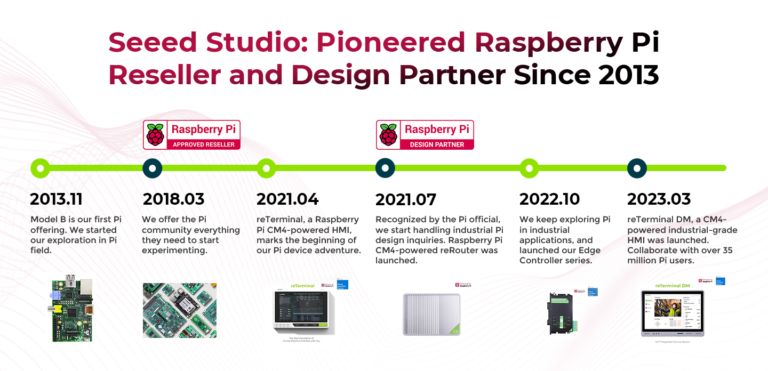Edge-Enhanced Face Detection: A Deep Dive with Raspberry Pi-Powered Devices
Introduction
In the dynamic realm of technology, edge computing has emerged as a game-changer, revolutionizing the way applications operate. Within this technological shift, face detection at the edge takes center stage, offering unparalleled efficiency and immediacy. This guide explores the crucial role of face detection in an edge computing environment, addressing the demand for real-time processing and heightened privacy. We’ll delve into methodologies, such as the Haar cascade method, and cutting-edge machine learning libraries like Google Media Pipe, shedding light on how this fusion is transforming industries.

Why Face detection at Edge is important?
- Low Latency:
- Reduces processing delays by executing face detection closer to the data source.
- Enables real-time applications, such as security surveillance and responsive user interfaces.
- Privacy Enhancement:
- Minimizes the need for transmitting sensitive facial data to external servers or the cloud.
- Addresses growing privacy concerns by keeping data processing localized.
- Real-time Processing:
- Facilitates immediate decision-making in applications like security, retail analytics, and healthcare.
- Enhances the overall responsiveness and effectiveness of face detection systems.
- Edge Computing Efficiency:
- Utilizes edge computing resources efficiently, optimizing the allocation of processing power.
- Reduces the burden on central servers, leading to more scalable and cost-effective solutions.
- Security and Surveillance Improvements:
- Strengthens security systems by enabling quick and accurate identification of individuals.
- Enhances surveillance capabilities in monitoring crowded spaces and public areas.
When it comes to face detection, choosing between the Haar cascade method and machine learning libraries like Google MediaPipe involves considering various factors.
- Haarcascade Method:
- Efficiency:
- Utilizes predefined features for efficient face detection.
- Computationally less intensive, suitable for real-time applications with limited resources.
- Robustness:
- Reliable in straightforward scenarios with clear facial features.
- Well-suited for applications where adaptability is not a primary concern.
- Resource-Friendly:
- Requires less computational power, making it suitable for resource-constrained environments.
- Ideal for applications with simpler face detection requirements.
- Efficiency:
- Google Media Pipe:
- Machine Learning Precision:
- Leverages machine learning for more accurate and sophisticated face detection.
- Adapts to diverse facial features, enhancing precision in complex scenarios.
- Adaptability:
- Learns and evolves, making it suitable for applications with varying facial characteristics.
- Excels in scenarios demanding advanced and adaptable face detection capabilities.
- Complex Scenarios:
- Particularly effective in scenarios with challenging lighting conditions, angles, or occlusions.
- Provides superior performance in applications requiring nuanced facial feature recognition.
- Machine Learning Precision:
What are the applications of Face Detection?
Security and Surveillance
Face detection at the edge is crucial for security and surveillance due to its real-time threat detection capabilities, ensuring immediate identification of individuals for quick response to potential threats. Privacy protection is enhanced as facial data is processed locally, complying with regulations and reducing privacy concerns. The approach allows for scalable and efficient resource allocation, distributing processing tasks and optimizing system scalability. Face detection at the edge is adaptable to various environments, offering flexible deployment options, weather resistance, and operational continuity in the face of network failures. Reduced network dependency minimizes bandwidth usage and ensures uninterrupted surveillance operations.
Retail Analytics
In retail, face detection at the edge contributes to personalized customer experiences through real-time analytics and targeted marketing strategies. The technology improves security and loss prevention by integrating facial recognition to identify shoplifters and prevent fraudulent activities. Efficient queue management is achieved through real-time footfall analysis, enabling optimized staff deployment and better customer service. The technology also optimizes inventory management by tracking customer movements for dynamic inventory control and placement. In terms of data privacy compliance, local data processing ensures adherence to regulations, and transparent consent mechanisms address privacy concerns, fostering customer trust.
Seeed Studio’s Raspberry Pi Ecosystem

Seeed Studio has been serving the Raspberry Pi user community since 2013 and took the lead to join the approved reseller and design partner. Since the first version of reTerminal in 2021, we have a series of products including reRouter, edge controller series, and this year reTerminal DM, serving creators, makers, enthusiasts, students, engineers, enterprises as well as industries, and every scenario needing Raspberry Pi.

More Resources
- Explore more products, full system devices, customization services, and use cases on the Seeed Raspberry Pi page.
- Download our latest Raspberry Pi success case booklet to know how Seeed and Seeed’s Raspberry Pi-powered products and solutions assist in tackling real-world challenges. Share your idea and story with our team at edge@seeed.cc.
- Dive deep into our Raspberry Pi wiki page to get yours started.
- Download our latest product catalog to find the ones that suit your needs.
- Wants to discuss more customization possibilities, please check out our customization services, and submit your inquiry to edge@seeed.cc to have a deeper discussion and evaluation for you.
